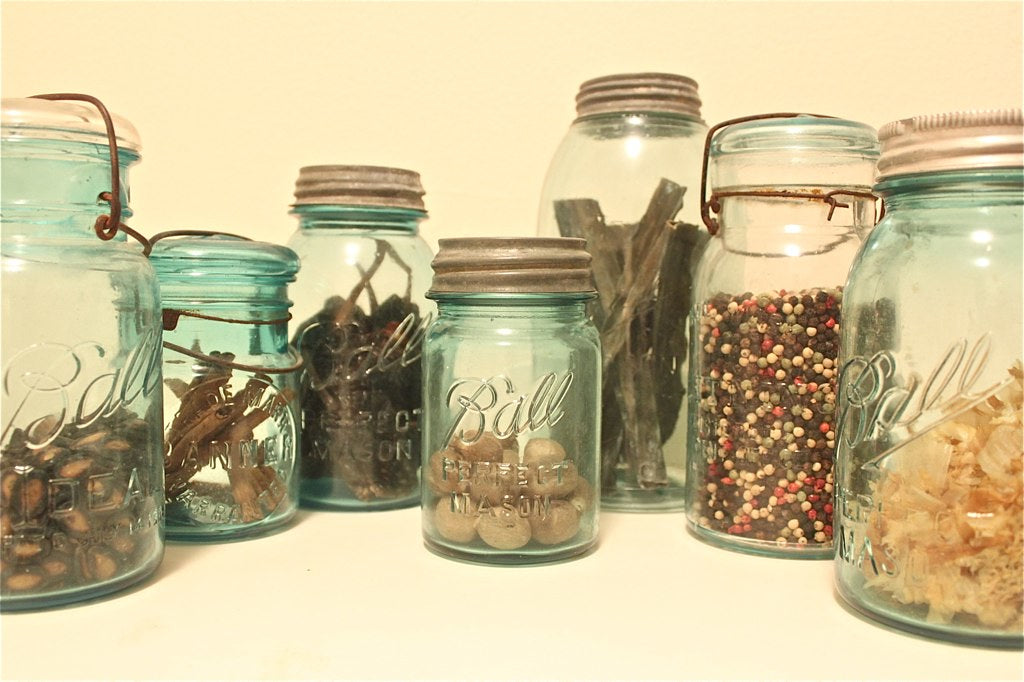Ball Jars Collector’s Guide: History, Identification, and Collecting Tips

If you grew up seeing rows of jars in your grandmother’s pantry, Ball Mason Jars have been used for canning, storing, and even decorative purposes. Today, they are also highly collectible. From vintage Ball jars in aqua or amber to limited-edition releases, these jars carry a story of American home life and craftsmanship.
History of Ball Mason Jars
The Ball brothers—Frank, Edmund, and George—established their company in Buffalo, New York, in 1880, with a product line that included tin cans with wooden jackets... Which isn't the reason we've come to love them today. And, by 1884, they were full steam ahead, shifting their business to glass production and introducing the Ball Mason Jar.
- 1884: The first jars are introduced into the market and made for home canning.
- 1890s–1910s: Simple block lettering marked the early jars, with different lid styles.
- 1930s–1950s: A variety of colors started making their way into kitchens, including aqua, green, and amber.
- 1970s–Today: Modern production emphasizes reliable sealing, with limited-edition runs made for collectors.
Collectors now keep an eye out for these early versions because of their logos, shades of glass, and embossing details.
How to Identify Ball Jars
When trying to figure out the age or authenticity of a Ball Mason Jar, people often look at three main details:
1. The Logo
- 1880s–1910s: Block-style “Ball” lettering.
- 1910s–1930s: A looser cursive script is introduced.
- Post-1930s: The logo script is refined and sometimes paired with dates stamped on the base of jars.

2. Glass Color
- Aqua: The standard color of early production, Ball Blue was a color effect due to the minerals in the sand used in production.
- Amber: Higher production costs means less amber jars were produced and typically are more collectible Ball Jars.
- Green: Another hard-to-find color, these vintage Ball jars were mostly produced from 1913-1915 and coincide with improvements being made in factory output at the time.
- Clear: Heavily leaned on from 1937 and on, clear glass was cheaper to produce and became the standard color of Ball Jars.
3. Lids
- Zinc lids: Found on the oldest jars.
- Two-piece lids: A later improvement for sealing.
- Plastic and modern metal lids: Current standard, though limited runs can also be collectible.
What Makes a Jar Valuable
Some jars are worth just a few dollars, while others sell for much more. Value usually depends on:

-
- Age and whether the jar carries an early logo or embossing.
- Ball jar colors... Especially rarer colors like amber, green, purple, or cobalt.
- Condition to check for any chips and cracks that are sure to drop the price quickly.
- Limited editions, which tend to attract collectors.
If you’re unsure how to identify Ball jars or their prices, price guides and online marketplaces can give a snapshot of current values.
Where to Find Collectible Bar Jars
- Antique stores and flea markets: Often home to older jars.
- Online listings: Sites like eBay, Etsy, and collector groups.
- Estate sales and auctions: Good for finding jars that have been carefully stored.
- Collector shows and clubs: Helpful for meeting others who share the same interest.
You never know when a box in someone’s attic might hold a treasure.
How to Care for Your Ball Jars
Once in your collection, a little care helps keep jars in good condition.
- Wash older jars gently by hand.
- Avoid sudden temperature changes, as they can stress the glass.
- Store upright, away from direct sunlight, to protect color.
- Keep notes and photos of your collection to track details.
Closing Thoughts
Ball Mason jars started as simple kitchen tools, but they've become reminders of changing styles, technology, and home life. For collectors, each jar offers both history and charm. Whether they sit on a pantry shelf or in a display case, Ball jars continue to show why they’ve lasted for more than 140 years.
Looking to collect other vintage glassware? Make sure to check out our guide to a variety of glassmakers right here.
FAQ: Ball Mason Jars
Q: What are Ball Mason Jars?
A: Ball Mason Jars are glass jars first introduced by the Ball Corporation in 1884. Initially designed for home canning, they have become collectible items prized for their colors, embossing, and historical significance.
Q: How can I tell if my Ball jar is vintage?
A: Look at the logo, glass color, and lid type. Vintage Ball jars often feature older scripts, such as block letters or early cursive, and colors like aqua, green, amber, or cobalt. Zinc or early two-piece lids also indicate age.
Q: Which Ball jar colors are the most valuable?
A: Rare colors like amber, green, cobalt blue, and purple are highly sought after. Aqua or clear jars are more standard when it comes to collectable ball jars, while unusual or limited-edition colors typically command higher prices.
Q: Are Ball Mason Jars collectible today?
A: Yes! Collectors value Ball jars for their history, design variations, and rarity. Older jars with unique embossing or limited-edition colors are especially prized.
Q: Where can I find collectible Ball jars?
A: Look at antique stores, flea markets, estate sales, auctions, and online marketplaces like eBay or Etsy. Collector clubs and shows can also provide access to rare or limited-edition jars.



